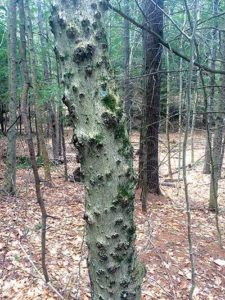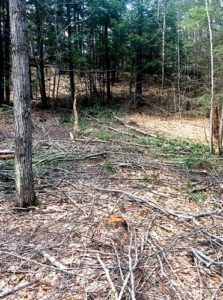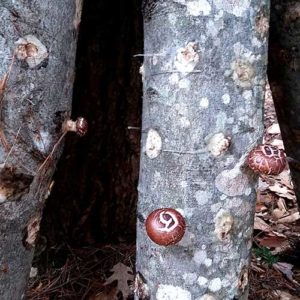 |
| A beech tree severely affected by beech bark disease. |
 |
| Postharvest view of a gap created during winter 2020 firewood cutting. Slash has been cut small and will decompose over the next few years; think of it as fertilizer for the next generation of trees. |
 |
| First flush of shiitake mushrooms on beech logs after a spring rain |
By Noah Gleason-Hart
Photos by the author
American beech (Fagus grandifolia) has a reputation among foresters, landowners and loggers as a “weed” with exasperating persistence and limited value. In some ways beech deserves this label. It is a prolific sprouter; when you cut one down, countless saplings spring from the roots and stumps of the tree. These saplings benefit from the large, established root systems of their parent trees and can aggressively outcompete new seedlings of other species. Beech is also very shade tolerant; it can survive under a closed canopy with little light for decades. After a harvest removes upper canopy trees and brings light to the ground, these sapling spring into action and can form pure beech stands.
Landowners and forestry professionals might view these attributes more favorably if beech had significant commercial value, but it does not. Some markets do exist for beech trees as mat and tie logs and as bolts for dowel production, but generally speaking, it’s a low-value species.
The presence of beech bark disease in the Northeast exacerbates negative perceptions of beech. In the past, beeches were a large-diameter climax species with stunningly clear, silver bark and a lifespan of several hundred years. However, most of the beech trees you’ll see on a walk through the woods today are affected by beech bark disease and are smaller, have heavily pockmarked bark, and are clearly in poor health. The interaction of an insect, beech scale, and a nectria fungus causes beech bark disease. The beech scale, a nonnative species accidentally introduced from Europe in the late 1800s, attacks the thin bark of beech. These wounds then serve as entry points for the bark canker fungus to take hold and impede sap flow through the tree.
Some beech trees display a natural resistance to the disease, but most are extremely susceptible. Affected trees slowly succumb and rarely reach old age or grow to large diameters. Stress to the main stem initiates a strong sprouting response similar to the response after a beech tree is cut down. These sprouts are as susceptible to beech bark disease as their parents, so a cycle begins that leads to pure thickets of small-diameter diseased beech.
Despite these challenges, beech still plays an essential role in the ecology of our woods. Beech is a prolific bearer of tasty nuts. You’ll often see claw marks on larger beech stems and bear baskets in tops of trees where a bear has pulled in branches to harvest nuts. The nuts are also a tasty treat for humans, if you can beat the squirrels to them! Beech thrive on a variety of sites and will grow and reproduce on soils that might not support other hardwoods. Finally, because it is shade tolerant, beech is well suited to the small-scale single tree disturbances common in New England forests before widespread harvesting began.
Beech is also a useful resource on the farm or homestead – especially if we take advantage of the characteristics of the tree, rather than try to fight them. On the farm where I live in southern Maine, we don’t actively promote beech, but we still have plenty of it in our woodlot, and we’ve found a variety of uses for it.
We use disease-free beech bolts for small-scale, log-grown shiitake mushroom cultivation. Sources list beech as only a second-tier species for mushroom production because it may not be as productive as red oak, white oak and sugar maple. Beech bark is also relatively thin, so the bark may crack and fall off earlier than that of other species, drying out the log and reducing years of production.
However, we’ve been quite satisfied with the yields we’ve seen, and in the third year of our project, we have yet to see any bark cracking. Most importantly, by using beech harvested while thinning mixed stands, or while harvesting groups of pure beech, we can leave more of our pole-sized oaks and maples to grow into valuable saw logs for future harvests.
Beech is an abundant, high-BTU firewood. On the farm, we use firewood harvests as an opportunity to cull diseased beech and create gaps in the canopy to regenerate other species. By removing diseased beech and controlling sprouts, and leaving trees that appear to show resistance, we also shape the gene pool to ensure that resistant trees are the ones that reproduce.
To increase our chances of regenerating other species, we timed our beech harvest in January 2020 to follow last year’s mast year for red oak. By happy coincidence, all indications are that we’ll also have a good seed year for white pine in 2020. We harvest groups of diseased trees together to bring more light to the ground and promote species, such as red oak and white pine, that are less tolerant of shade than beech.
The beech stumps left behind will respond with aggressive root and stump sprouting, so we’ll need to go back to each of the gaps several times to cut sprouts and ensure that light reaches other seedlings. If other species don’t regenerate well, or if we do a poor job controlling beech sprouts, we may end up with another stand of pure beech rather than the mixed species stand we’d like to see. In that case we’ll harvest beech firewood from the same area again. This wouldn’t be an ideal outcome, but we’ll still be producing a renewable, homegrown resource.
We can also put the aggressive sprouting tendencies of beech to use by harvesting small-diameter stems for ramial chips and biochar for our gardens and orchards. Inexpensive or free wood chips are often available from arborist companies, but ensuring that chips from tree companies are predominantly hardwoods – preferable to softwoods for ramial chips – can be challenging. To ensure that our mix is mainly from hardwoods, we chip several truckloads of beech saplings every year for our small orchard. The trees we cut will re-sprout, and we can come back in five or 10 years to harvest again. Similarly, the aggressive sprouting of beech would ensure a steady source of biomass for biochar production. We haven’t tried this yet but are interested in exploring biochar options in the future.
I encourage woodlot owners and homesteaders to reimagine the role of beech in their woodlots. When you find large-diameter, clear-barked beeches, consider leaving them as disease-resistant seed sources for the future. In my mind, few things are more beautiful than a large, clear-barked, single-stemmed beech. We should work to regenerate other species in beech-dominated stands but recognize that diseased beech will remain a part of our landscape. Therefore, we should find creative and productive ways to put that resource to good use on our farms and homesteads.
Noah Gleason-Hart is MOFGA’s low-impact forestry specialist. You can contact him at [email protected].
